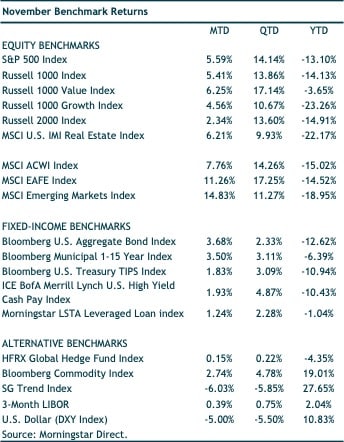THE MONTH AT A GLANCE
- Equity markets surged in November with emerging-market equities outperforming their developed market counterparts
- The prospect that U.S. inflation may have finally peaked brought on the hope that Fed interest begin slowing interest rate hikes
- Amid widespread domestic protests, there were signs that China’s strict zero-COVID rules may finally be loosening
- Government bond yields dropped during the month boosting core bond returns and further inverting the yield curve
MARKET RECAP
The stock market continued to rally in November on the hope that interest rate increases would slow. The S&P 500 gained 5.6% last month. This narrows the year-to-date loss to 13.1%. The month started off on shaky footing following the November 2nd FOMC statement and press conference. The S&P 500 fell nearly 4% in the first three days of November—before staging nearly a 10% rally to close out the month. Equity markets shrugged off Chair Powell’s hawkish comments during his presser and surged higher during the month.
It is worth noting that two events drove the preponderance of market gains last month. The first event was the November 10th CPI release (for the October inflation reading). Both the 7.7% year-on-year and 0.4% monthly CPI figures were below consensus. It was the first sub-8% headline inflation reading in eight months. This sparked a strong rally in both stocks and bonds. On November 10th, the S&P 500 gained 5.6%, while the Bloomberg US Aggregate Bond Index was up 2.0%.
The second large gain in November came on the last day, following Chair Powell’s speech at the Brookings Institution. Powell confirmed that smaller interest rate hikes were coming—and all but confirmed that a 50 basis point hike could start in December. This helped the S&P 500 gain 3.1% that day. The 5.6% daily gain on November 10th and 3.1% daily gain on November 30th accounted for all (and then some) of the full month return of 5.6%.
Developed international and emerging-markets equities posted their best monthly gains in years, and their best month relative to US equities since May 2009. MSCI EAFE gained 11.3% in the month, while MSCI EM jumped 14.8%. The US dollar’s 5% reversal during November played a part in the outperformance of foreign stocks. Much of emerging-markets’ strong performance was driven by Chinese equities. After nearly a 30% drubbing in September and October during the lead up to the 20th National Congress, the MSCI China Index jumped nearly 30% in November. This was the best monthly return for Chinese stocks since the late-1990s. Rumors and signals around a loosening of China’s harsh zero-COVID policy was a big reason for the jump in Chinese stocks.
The Fed delivered its fourth straight 75 basis points rate hike in early November—bringing their target fed funds rate level to 3.75%-4.0%. A smaller 50 basis point hike in mid-December is widely expected. There is then a month and a half until the following Fed meeting, and less clarity on the size and speed of hikes next year. However, the market has started to bid up risk assets with the belief that monetary policy will be less aggressive going forward. Rates fell in the US last month, resulting in a positive return of 3.7% for the Bloomberg US Aggregate Bond index. Corporate spreads narrowed during the month, which helped investment-grade corporates outperform the core bond index. The ICE BofA US Corporate index gained 4.9%, while the ICE BofA US High Yield index lagged with a gain of 1.9%.
Higher rates in the US resulted in a negative return of 1.3% for the Bloomberg US Aggregate Bond index. Corporate spreads narrowed during the month, which helped corporates outperform the core bond index. The ICE BofA US Corporate index fell 1.1%, while the ICE BofA US High Yield index fared well with a gain of 2.8%.


